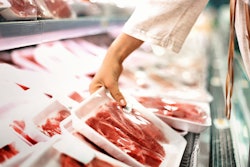
The timely movement of foodstuffs has always been a complex undertaking for global supply chains. The mix of short expiration windows for dairy, meat and produce, added to overhead costs for specialized, temperature-controlled storage and transportation, plus the occasional border inspections and tariff duties, end up producing thin profit margins for the industry when everything works—or big losses when a single, jigsaw puzzle-like piece falls out of place.
Still, as the country endures another month of the pandemic’s impact, the food logistics sector is experiencing an unprecedented distortion of supply and demand equilibrium. There is no shortage of the food supply in the United States today. Farms and ranches are producing. Warehouses are full. And, consumer demand is soaring. This is due, in part, from panic buying. The larger picture is that homes, grocery stores and even food banks are experiencing a huge spike in demand, while the bulk of orders that normally come from restaurants, hotels, businesses and live event catering have nearly evaporated.
However, the industry is coping with altered end points in the food supply chain and the need to quickly pivot. Other supply side bottlenecks are causing farmers to plow vegetables and dump milk, while empty shelves continue to dog some supermarkets and big box outlets. In the value chain from farm to consumer, the industry’s logistics concerned with packing, storage and final delivery have been hit by a shortage of both workers and replacement parts for worn and damaged equipment. Both shortages are secondary effects of the current health and safety requirements. In this environment, digital solutions targeting specific chokeholds in the supply chain are needed to enable the food logistics industry to recover with maximum efficiency.
Extend digital solutions throughout the value chain
In the last decade, researchers specializing in “Ag Tech” have made great headway leveraging drones, robotics, artificial intelligence (AI) and Internet of Things (IoT) sensors in the field to optimize agricultural resources such as water, fertilizer and other inputs while maximizing acreage yield. This has led, in one example, to this season’s bonanza crop of russet potatoes normally sold to restaurants. But, farmers are letting them rot or giving them away. Why? Because they can’t switch quickly enough from packing the potatoes in 50-pound boxes or 2,000-pound bags to the smaller sizes sold in supermarkets.
The solution is to build upon the technology already used by farmers. Software tools can extend and integrate disparate systems so that other specialists in the supply chain can quickly share real-time data and insights. For a farmer, this can mean the difference between locating a supplier with the right packaging equipment vs. letting food go to waste.
In the field and the roadways, data-gathering technology should be improved too. Mobile devices, when used by field operators, need to support offline use or work in locations where internet connectivity is unreliable. Companies should be able to track the movement of food commodities and monitor spoilage at every stage of transportation, from field to storage to delivery at the loading dock or consumer’s doorstep. This increased visibility enables quick, targeted responses and troubleshooting in the case of unforeseen disruptions.
Regionalize a nimbler food supply chain
To ensure food security for consumers, logistics providers should leverage predictive analytics and AI tools to enable sophisticated capacity planning. Consider Amazon’s example of scouring user orders, big data and geographically relevant business intelligence to anticipate the likelihood of future orders and stock their regional warehouses accordingly to optimize speed of delivery. Food logistics providers can deploy similar AI-enabled tools and data analytics to flag potential surges in consumer demand and direct commodities to warehouses accordingly. The same application will enable truckers and fleet operators to maximize the freight volume of each container.
Agile, optimized responses to route changes—caused by traffic snarls, unexpected demand surges or fragility of perishable contents—is another strategic need for transportation logistics. Empowering drivers using handheld mobile devices with visibility into back office ordering and billing data or inventory management will enable delivery personnel to execute changes in real-time, reducing supply chain bottlenecks. Such data-driven tools (perhaps protected with blockchain and location intelligence) should also be available to third-party contractors. After all, it is often UPS, FedEx, DHL or a local carrier that delivers the goods to the consumer’s door. The seller’s reputation ultimately depends on the successful completion of this “final mile.”
Deploy new apps to enable social distancing
Though required by contract, signatures on freight receipts or bills of lading have become difficult to obtain with limited in-person interactions. Companies can avoid fraud and liability by creating digital “proof of delivery” applications. Mobile apps that tie-in iPhone photos with a delivery truck’s GPS location tag and timestamp can serve as a digital receipt. By adding blockchain protection to the mobile application, companies can create a secure digital ledger for tamper-proof verification.
Use software to stay ahead in a volatile economy
The importance of leveraging technology to extract operational efficiencies, apply customized solutions and deploy data-driven innovations need not overwhelm food logistics providers. Today, the widespread market acceptance of robust low-code software development platforms has enabled cost-effective collaborations between sourcing managers, procurement specialists, logistics operators and IT professionals. Visually driven, low-code development platforms democratize the creation of digital solutions, getting new apps up and running quickly for fast impact and ROI.
Effective communication to enable real-time responses to changing conditions is the key underscoring each of these digital solutions. The market is hungry for providers to fill these gaps in their existing systems.


















